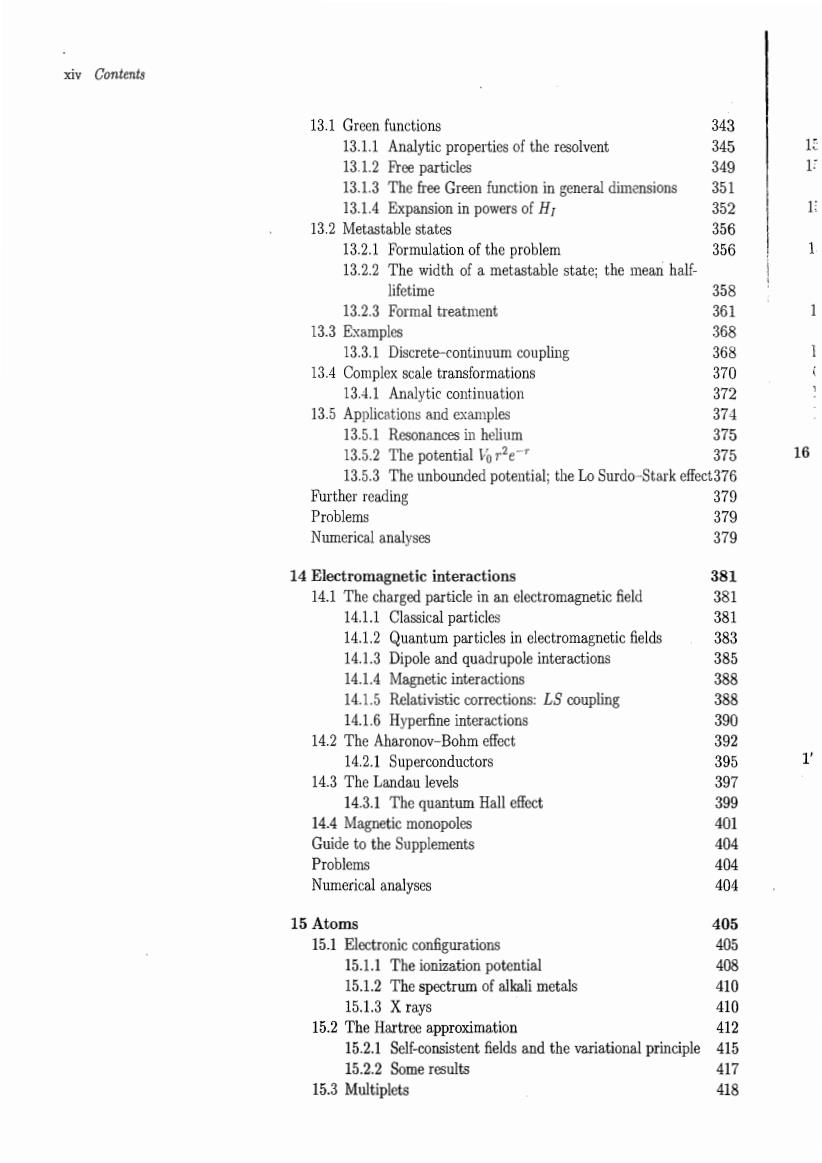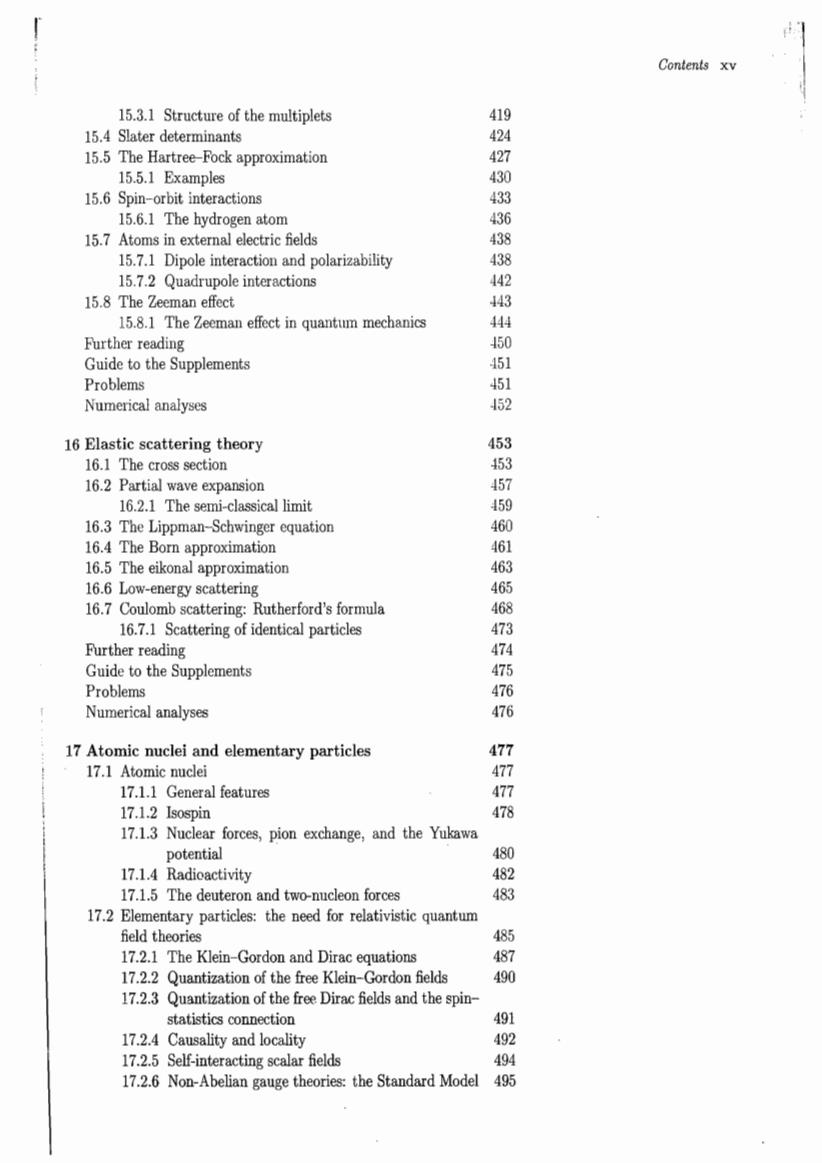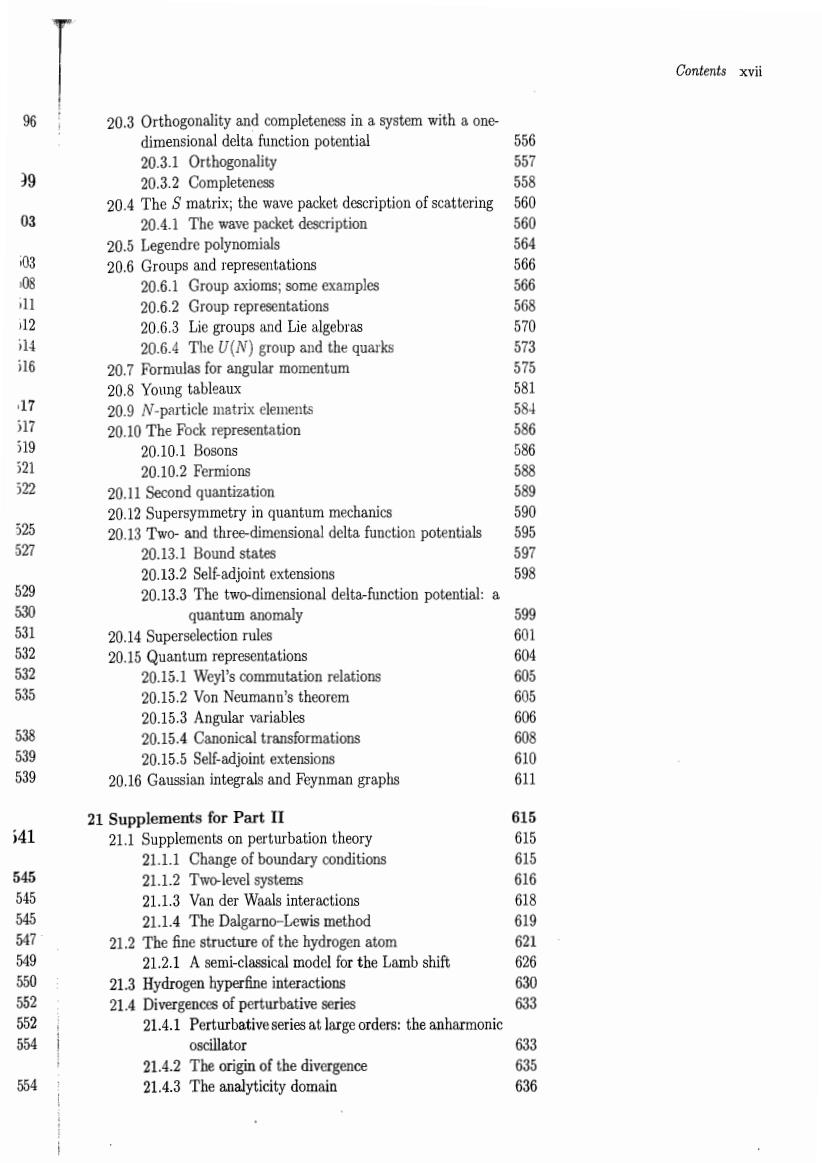
11 The semi-classical approximation 265 11.1 The WKB approximation 265 111.1 Connection formulas 268 11.2 The Bohr-Sommerfeld quantization condition 271 11.2.1 Counting the quantum states 273 11.2.2 Potentials defined for >0only 2 the meaning of the mt 0 124 11.2.5 11.2.6 Examples 282 11.3 The tunnel effect 283 11.3.1 The double well 285 11.3.2 The semi-classical treatment of decay processes 2 11.3.3 The Gamow-Siegert theory 11.4 Phase shift 295 Further reading 300 300 0咖 Ill Applications 303 12 Time neral fe tures of time evolution 12.2T -dependent unitary transformations 12.3Ad abatic processes 311 12.3.1 The Landau-Zener transition 313 12.3.2 The impulse approximation 12.3.3 The Berry phase 12.3.4 Examples 318 12.4 Some nontrivial systems 320 12.4.1 A particle within moving walls 320 10A9R nant oscillati 324 1943A 1244Agw他 gasolenoid 12. 331 12.5】 Inverse linear variation of the frequency 335 12.5.2 The Planck distribution inside an oscillating cavity 336 12.5.3 General power-dependent frequencies 338 12.5.4 Exponential dependence 12.5.5 Creation and annihilation operators:coupled os- cillators 340 Guide to the Supplements 341 Problems 34 Numerical analyses 42 13 Metastable states 343

xiv Contents 13.1 Green functions 343 出he 345 349 1 13.1.3 The free Green function in general dimensions 351 131.4Exp sion in powers ofH 352 1 13.2 Metastable state 1 The ifetime 358 13.2.3 Formal treatment 361 1 13.3 Examples 368 13.3.1 Discrete-continuum coupling 368 13.4 Complex scale transformations 370 13.4.1 Analytic continuation 372 13.5 Applications and examples 13.5.1 Resonances in he 375 1 The potential 375 16 .5.3The ntial;the Lo Surdo-Stark effect376 Furthe ded pot Numerical analyses 14 Electro agnetic interaction 381 14.1Th rged particle n an electromagnetic field 38 14.1.1 Classical particle 381 14.1.2 Quantum particles in electromagnetic fields 383 14.1.3 Dipole and quadrupole interactions 385 14.1.4 Magnetic interactions 14.1.5 Relativistic corrections:LS coupling 388 14.1.6 Hyperfine interactions 390 14.2 The Aharonov-Bohm effect 392 14.2.1 Superconductors 395 1" 14.3 The Landau levels 397 143.The quantum Hall efect Problems Numerical analyses 404 15 Atoms 405 15.1 Electronic configurations 5 15.1.1 The ionization potential 408 15.1.2 The spectrum of alkali metals 410 15.1.3 X ravs 15.2 The Hartree approximation 15.2.1 Self-consistent fields and the variational principle 415 15.2.2 Some results 417 15.3 Multiplets 418

| Contents x 15.3.1 Structure of the multiplets 15.4 Slater determinants 15.5 The Hartree-Fock approximation 15.5.1 Examples 15.6 Spin-orbit interactions 433 15.6.1 The hydrogen atom 436 15.7 Atoms in external electric fields 438 15.7.1 Dipole interaction and polarizability 438 15.7.2 Quadrupole interactions 442 15.8 The Zeo an effect 443 15.8.1 The Zeeman effect in quantum mechanics Guide to the Supplements Problems Numerical analyses 16 Elastic scattering theory 16.1 The cross section 16.2 Partial wave expansion 57 16.2.1 The semi-classical limit 5 16.3 The Lippman-Schwinger cquation 16.4 The Born approximation 461 16.5 The eikonal approximation 3 166o 465 erinRutherford's formul ng Guide to the Supplements Problems Numerical analyses 17 Atomic nuclei and elementary particles 477 17.1 Atomic nuclei 17.1.1 General features 477 17.1.21s0spin 17.1.3 Nuclear forces,pion exchange,and the Yukawa potential 17.1.4 Radicactivity 171 5 The deute and two-c forces 17.2 Eler for relativistic quantum 485 The Klein-Gordon and Dirac equations 17.2.2 Quantization of the free Klein-Gordon fields 17.2.3 Quantization of the free Dirac fields and the spin- statistics connection 491 17.2.4 Causality and locality 492 17.2.5 Self-interacting scalar fields 494 17.2.6 Non-Abelian gauge theories:the Standard Model 495

xvi Contents Further reading 496 20 IV Entanglement and Measurement 499 2 18 Quantum entanglement 503 18.1 The EPRB Gedankenerperiment and quantum entange 2 24 182 Aspect's experimen 18.3 Entanglement with more than two particles 511 18.4 Factorization versus entanglement 512 18.5 A measure of entanglement:entropy 514 Further reading 516 19 Probability and measurement 517 19.1 The probabilistic nature of quantum mechanics 517 19.Measurement and state preparation:from PVM to POVM519 19.3 Measurement "problems" 521 19.3.1 The EPR"paradox" 522 19.3.2Meas decoherence 27 19.3.4The nger'sca fundamental postulate versus Schrodinger's equation 529 19.3.5 Is quntum mechanics exact? 530 19.3.6 Cosmology and quantum mechanics 531 19.4 Hidden-variable theories 532 19.4.1 Bell's inequalities 532 19.4.2 The Kochen-Specker theorem 535 19.4.3 "Quantum non-locality"versus"locally causal the- ories"or"local realism" 538 Further reading 530 Guide to the Supplements 539 2 V Supplements 541 20.1C18 20.1.1 The Lagrangian formalism 545 20.1.2 The Hamiltonian(canonical)formalism 20.1.3 Poisson brackets 54g 20.1.4 Canonical transformations 550 20.15 The Hamilton-Jacobi equation 552 20.1.6 Adiabatic in 552 of electromagneticrait 554 20.2 vacuum 564

Contents xvii 96 20.3 Orthogonality and completeness in a system with a one- dimensional delta function potential 20.3.1 Orthogonality 20.3.2 Completeness 20.4 he】 packet description of scattering 4.1 The the wave p wave】 et descriptio 20.5 Legendre p 03 20.6 Groups and representations 20.6.1 Group axioms;some examples 20.6.2 Group representations 568 20.6.3 Lie groups and Lie algebras 20.6.4 The U(N)group and the quarks 573 20.7 Formulas for angular momentum 575 20.8 Young tableaux 17 519 representation 20.10.1B 521 20.10.2 Fermion 20.11 Second quantiz 5 20.12 Supersymmetry in quantum me chanics 20.13 Two-and three-dimensional delta function potentials 20.13.1 Bound states 597 20.13.2 Self-adjoint extensions 598 529 20.13.3 The two-dimensional delta-function potential:a 530 quantum anomaly 599 531 20.14 Superselection rules 532 20 15 Quantum representations 604 532 20 15.1 Weyl's commutation relations 535 20.15.2 Von Neumann's theorem 20.15.3 Angular 538 20154C tra ations 539 20.15.5Sel e ons 20.16 Gaussian integrals and Feynman graphs 21 Supplements for Part II 41 21.1 Supplen ation theory 45 21.1.2 Two-level systems 21.1.3 Van der Waals interactions 545 21.1.4 The Dalgarno-Lewis method 547 21.2 The fine structure of the hydrogen atom 21.2.1 A semi-classical model for the Lamb shift 626 21.3 Hydrogen hyperfine interactions 21.4 Div rie 69 21.4.1 Perturbativeseries largeorders the anharmonic 554 214 The orig of the 54 21.4.3 The analyticity domain